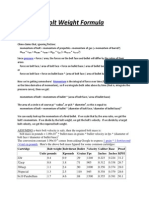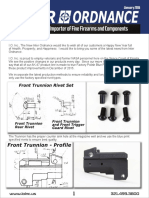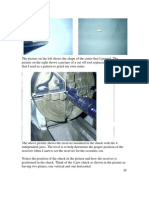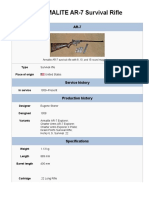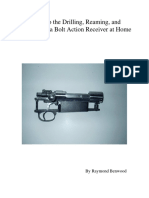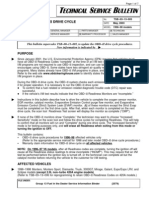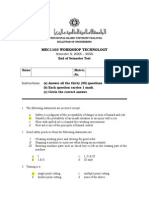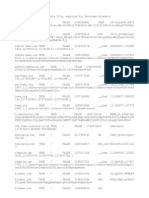Fluted and Annular Grooved Barrel Chambers in Firearms
Fluted and Annular Grooved Barrel Chambers in Firearms
Uploaded by
snizzCopyright:
Available Formats
Fluted and Annular Grooved Barrel Chambers in Firearms
Fluted and Annular Grooved Barrel Chambers in Firearms
Uploaded by
snizzCopyright
Available Formats
Share this document
Did you find this document useful?
Is this content inappropriate?
Copyright:
Available Formats
Fluted and Annular Grooved Barrel Chambers in Firearms
Fluted and Annular Grooved Barrel Chambers in Firearms
Uploaded by
snizzCopyright:
Available Formats
Vaclav K r c m a 1
Fluted and Annular Grooved Barrel Chambers in Firearms
REFERENCE: Krcma, V., "Fluted and Annular Grooved Barrel Chambers in Firearms," Journal of Forensic Sciences, JFSCA, Vol. 41, No. 3, May 1996, pp. 407-417. ABSTRACT: The identification of suspect firearms by fluted and annular grooved barrel chamber markings on fired cartridge cases is described. KEYWORDS: forensic science, criminalistics, firearms identification, cartridge case identification, fluted and annular grooved barrel chambers
What Is a Barrel Chamber Flute? Barrel chamber flutes are longitudinal grooves cut in the chamber of a firearm that allow propellant gases to surround the fired cartridge case thereby equalizing interual and external gas pressures, which facilitate extraction or bolt operation in a delayed blow-back firearm design. (Note:) In the Heckler & Koch HK-4 semiautomatic pistol Caliber .380 (Fig. 1) there is a longitudinal flute barrel chamber design that is intended to retard case extraction rather than to facilitate case extraction. The flutes in this design are dimensioned so the case metal forced into wide, closed-end grooves must be forced back out of the flutes as the case moves to the rear. No gas flows between the case and chamber walls. In all other designs the flutes in addition to channeling propellant gases, are dimensioned such that any expanded case metal will slip out of the open-end grooves as the case moves rearward. Factors Affecting the Identification Value of Flutes Flutes are found in the chambers of some semi and full automatic pistols, semi and full automatic rifles, submachine guns and machine guns. They vary in number (2 to 18), shape, length and width, and leave corresponding impressions on a fired cartridge case. The forensic firearms examiner can often determine the type, model, and caliber of the suspect firearm through examination of the flute impressions on the fired cartridge case. Similarly, some weapons can be eliminated as possible suspects. Flute patterns are most often identifiable as swellings of fired cartridge case metal; however, a few are identifiable only as patterns of pronounced firearm discharge residue on the spent cartridge case. The latter have to be handled carefully to avoid disturbing the residue pattern through poor handling or rubbing. The length of the flute impressions on fired cartridge cases 1Former Head of the Forensic Ballistics Section, Attorney General's Crime Laboratory, Toronto, Ontario; and Medical-Legaland Police Science Laboratory, Montreal, Quebec, Canada. Received for publication 1 May 1995; revised manuscript received 11 Sept. 1995; accepted for publication 13 Sept. 1995.
varies. On some cartridges the flutes are found only in the cartridge neck and shoulder area. Examples are the Russian Tokarev 1938 and 1940 rifles (Fig. 2), People's Republic of China (PRC) Model 1980 pistol (Fig. 3) and PRC Type 64 Submachine gun (Fig. 4). With the exception of the Italian Machine Guns Fiat 38 and Breda 30 the flutes do not cover the whole length of the cartridge case. There is always a fluteless area at the rear end of the cartridge case to seal the chamber and prevent the propellant gases from entering the receiver. Test fired cartridges will very seldom show the perfect impression of all flutes; but it is less important since the number and width of the flutes are of great significance. It is possible to get excellent flute impressions by using factory pressure test cartridges; however, these are not always available.
FIG. 1--HK 4 pistol, H&K Germany, Ca1.380, 3 retarding flutes; Cal .22LR, 8flutes.
407
Copyright 1996 by ASTM International
408
JOURNALOF FORENSIC SCIENCES
iff
7.62'o oe (7.72"o o~} ~'
120"
/~ 0.I -0.2
FIG. 4~Type 64, silent submachine gun, PRC, Cal 7.62 25 mm b.n., 3 flutes.
FIG. 2--Flute impressions on cartridge cases. A) Tokarev Model SVT 1938 & 1940 s.a. rifles, Russia, Cal 7.62 X 54 mm R, 14flutes; B) PE 57, Swiss, Cal 7.5 X 55.5 ram, 8 flutes in 4 pairs; C) G 3 Heckler & Koch, Germany, Ca1.308, 12flutes; D)H&K33, Ca1.223, 18flutes; E) Russian cartridge 7.62 X 39 mm fired in RPG rocket launcher training device. It bears 4 very deep impressions of the rifling 4-R.
The factors affecting the quality of flute impressions are as follows: a) the hardness and thickness of the cartridge case (some manufacturers use harder brass than others); b) type and pressure of propellant; c) size and condition of the chamber; and d) depth and shape of the flutes. Some same-caliber weapons have the same number of flutes. For example, the German Heckler & Koch semi-auto rifle Model 300 Ca122 WMR 16 flutes; and the American Grendel Pistol (Fig. 5) and Model P-30 Ca122 WMR 16 flutes. In this case, an accurate identification (of the type of weapon involved) can be made by distinguishing the flute patterns of the Model 300 semi-auto rifle, which produce pronounced expansion of the cartridge case from those of the Model P30, which are pronounced only by powder residue impressions. Other examples can be more difficult. These include the German Heckler & Koch Model 43 (M88)SEATO Cal .223 16 flutes; the French FAMAS military assault rifle (Fig. 6A) Cal .223 16 flutes; and the Spanish AMELI LMG (US designation MG 82) (Fig. 7)
FIG. 3--Mode! 80, full auto pistol, PRC, Cal Z 62 25 mm b.n., 6flutes.
FIG. 5--Grendel pistol, USA, Cal .22 WMR, 16flutes.
KRCMA . FLUTED AND ANNULAR GROOVED BARREL CHAMBERS
409
FIG. 6--FAMAS military assault rifle and Shkas aircraft machine gun. A) Famas, Barrel cross section, France, Ca1.223, 16flutes; B) Shkas Aircraft MG, Russia, Cal 7.62 54 mm R, number of flutes unknown.
Cal .223 16 flutes. In these weapons, the cartridge case identification has to be supported by the following: fLring pin, breech block face, ejector, extractor, and ejection port markings.
What Is an Annular Grooved Barrel Chamber?
Annular and helical grooves are cut in barrel chambers to permit propellant gases to expand the walls of the fired case into these grooves, thereby causing resistance to extraction or case projection of the bolt.
Factors Affecting the Identification Value o f Annular or Helical Grooved Barrel Chambers FIG. 7--Cetme Spam LMG (Ameli or MG 82), Spain, Ca1.223, 16flutes.
i1
KIMBALL PISTOL
Annular or helical barrel chambers are generally found in lower pressure, straight cased, cartridge weapons. The basic factors affecting identification are generally the same as those with fluted chamber barrels. However, case markings tend to be obliterated by the extraction or case projection process. Initial radial expansion or residual patterns are overrun by longitudinal scrape striations. Nevertheless, the location and the number of distinctive expansion marks can usually be determined by close examination. Examples include the following semiautomatic pistols: the American Kimball Cal 7.62 33 (Fig. 8); the American HiStandard T-3 9 mm Para (Fig. 9); the PRC Type 1964 7.65 17
J
FIG. 9--Hi-Standard Model T-3 pistol, USA, Cal 9 mm Para, one retarding annular groove.
FIG. 8--Kimbal pistol, USA, Ca1.30 CAR (7.62 33 ram); Arrow A) shows fire-formed shoulder; and Arrow B) shows 14 shallow annular grooves.
410
JOURNALOF FORENSIC SCIENCES
mm (rimless) (Fig. 10); and the PRC Type 1977 7.65 17 mm (rimless) (Fig. 11).
Fluted and Annular or Helical Grooved Barrel Chambers in Pistols
There are two types of machine patterns found in semiautomatic pistol barrel chambers. Flutes to assist initial extraction and retarding annular and helical grooves.
Flutes to Assist Initial Extraction and Accelerate Slide Operation
These are found in the German H&K P-7 pistol (Fig. 12); and its variations, for example, P7M8, P7M13, P7M13SD, P7M8ST, the German H&K P9S and H&K 4 in Ca122 LR, the Italian Benelli Model B-76, the PRC Model 1980 (Chinese copy of Mauser Mod. 712 (1932) (semi and full automatic), and the USA Grendel P-30 and Auto Mag II (Fig. 13) pistols.
Retarding Annular and Helical Grooves
FIG. lO---Type 64pistol, PRC, Cal 7.62 mm, rimless, 4 retarding helical grooves.
Their purpose is to slow down the opening of the slide to enable the use of a relatively light slide and recoil spring, thus a lighter firearm. Retarding flutes are found in several American experimental pistols. There is an annular groove in the HI-Standard Model T-3 experimental pistol in the forward part of the chamber. The re-sizing effort required for the cartridge case ejection retards the movement of the case and slide, and allows the use of blow-back rather than locked action. The Kimball experimental pistol chamber has 14 rather shallow annular grooves, the impression of which is found on the fired cartridge case. In addition, the fired cartridge case expands into an enlargement cut in the front of the barrel chamber and creates the appearance of a bottleneck cartridge. Only one mass-produced semiautomatic pistol using an annular groove flute is encountered in the USA. It is the PRC Model 77 (1977-DA) Caliber 7.62 17 mm rimless onehand cocking pistol, which has an annular groove in the chamber. Firing results in a bulge in the cartridge case measuring approximately 8.58-8.59 mm in diameter. The re-sizing of this bulge in the process of extraction slows down the slide.
FIG. 11--Type 77, Onehand pistol, PRC, Cal 7.62 mm, rimless, 1 retarding annular groove.
KRCMA , FLUTEDAND ANNULARGROOVED BARRELCHAMBERS 411 200
I
"f' i
. . . .
'5- ___L
/
/ / //I///'1
Mloo:I
//
,/X~/////7>,,
FIG. 12--P 7 pistol H&K Germany, Cal 9 mm Para, 17 flutes.
The PRC Model 64 (1964-DA) Caliber 7.65 17 nun rimless is the only pistol manufactured anywhere using four helical flutes. These are very shallow and appear as small swellings on the fired cartridge case mad are very difficult to identify.
Fluted Barrel Chambers in Semi and Full Automatic Rifles
The first mass-produced military semiautomatic rifles known to have chamber flutes were the gas operated, locked-breech, Soviet
FIG. 13--Auto Mag II, USA, Cal .22 WMR, 12 round retarding impressions.
Tokarev Models 1938 and 1940. Both have flutes in the chamber neck area to assist initial extraction. Most semi and full auto rifles using fluted chambers were produced after W W I I and these were delayed, blow-back operated design. They depended upon fired case projection under residual pressure to permit the case to act as a piston to overcome a mechanically delayed bolt operating system. Without the barrel chamber flutes (or lubrication), the cartridge case would not move with sufficient force to move the bolt without the case being torn in two. This would occur because the front section of the case tends to adhere more tightly to the chamber walls than the thicker rear section. In all blow-back and delayed blow-back systems, the cartridge cases are projected from the chamber by propellant gases. The extractor is used only to hold the fired cartridge case in its place in the bolt face for ejection. The leader in this field was the German Heckler & Koch Company, which has produced the rifles shown in Tables 1 and 2.
412
JOURNALOF FORENSIC SCIENCES
FIG. 14---Star Model Z-70 submachine gun, Spain, Cal 9 mm Para, either 14 or lO flutes.
TABLE 1--Rifles produced by the German Heckler and Koch company. Rifles Cal 7.62 51 mm: G3 (Fig. 2); G3 A1 to A4; G3E G3k GR 7 G3/SG1; G3SG1L; PSG1 MSG 90; MSG 90E HK 91 A1 to A5; SR9 HK 41 Semi and full auto Standard models Short barrel Optical sight only Rifles for snipers Semi auto only Semi auto only~German version
TABLE 2--Rifles produced by the German Heckler and Koch company. Rifles Cal 5.56 51 mm: HK 33 (Fig. 2); HK 33E1 HK 33k; HK 33kE; HK 33kE1 HK 33/SG1 GR 3 HK 93 A1 to A5 HK 43 HK 53; HK 53 E1 HK G41; HK 41k Semi and full auto Standard models Short barrel Sniper Optical sights only Semi-auto only Semi auto only--German version Short barrel and short receiver SBarrel 450 mm Housing modified [short barrel
NOTE--All of these rifles have 12-flute barrel chambers.
NOTE--All of these rifles have 18-flute barrel chambers.
KRCMA 9 FLUTEDAND ANNULAR GROOVED BARRELCHAMBERS 413
TABLE 3--Pistols fluted and annular grooved chambers. Country Germany Model H&K P7 Cal 9 nun Para No. of Flutes 17 Remarks The first 479 pistols were marked "PSE" The production of the P7 started 1 May, 1979. Approximately 79,700 pistols were made. The flutes in the P7 barrel are 20 ~ apart (16 20 = 320). At 6 o'clock there is 40 gap between the flutes due to the gas port in the barrel. The flute width is 0.45 + 0.1 mm, and the flutes end 9.5 mm from the bottom of the cartridge case. M8 indicates 8 shot magazine. M13 indicates 13 shot magazine. Flute width 0.45 mm. 13 shot magazine, with lever safety. Barrel threaded for silencer. Weapon and magazine of stainless steel. 10 shot magazine. Production start 1977. Flute width 0.45 mm. The flutes are 20 ~ apart. Produced since 1968. Retarding longitudinal grooves in HK4 were used only since Oct/68. The earlier production only had a smooth chamber. Year of Production 1968-1984. Serial No. 10,001 to 36,550 (total 26,550 pistols). Some were made in Cal.32 ACP & .22 LR. HK4 pistols for Harrington & Richardson in USA were serial numbered 001-8,700. From 1970 to 1974 12,400 pistols were produced for the German customs in Cal .32 ACP Ser No. 40,001-52,400. 555 pistols (P4) were produced by Manufacture Nationale D'armes de Saint Etienne Mas. (production 1973-74). These were delivered to Berlin Police. The flutes are 45 ~ apart (8 45 = 360). The flute width is 0.5 ram. Only minor traces of powder residues found on fired cartridge case. Helical retarding flutes in the chamber. They cover the whole chamber. Difficult to identify. Flute impressions have expansion form or bulges. Flute width 1.9 rnm, depth 0.75 mm. 1 retarding annular groove in the chamber. Expansion of the fired cartridge case measures approximately 8.58-8.59 mm. Flutes are located on the neck and shoulder area of the fired cartridge case. Re-designed copy of Mauser full auto M 712 (1932) pistol. 18 equally spaced holes in the chamber. (3 sets of 6 each), but only 12 of them leave round impressions on the fired cartridge case. The flutes on the fired cartridge case are pronounced in powder residues only. H&K rifle Mod 300 also has 16 flutes but these produce metal expansion. 14 thinly pronounced shallow annular grooves found on the lower half' of the fired cartridge case. An enlargement in the chamber fireforms a shoulder on the fire cartridge, creating a false impression of a bottle-necked cartridge. One retarding annular groove. Very shallow barrel chamber flute impressions. Some fired cartridge cases show hardly any evidence of flutes. 6 spiral grooves in the barrel chamber--reported by E. Thompson Forensic Science Laboratory, Indianapolis, IN.
P7 M8 P7 M13 P7 P7 P7 P7 M13S M13SD M8 ST M10
9 mm Para 9 mm Para .40 S&W 9 mm Para 9 nun Para 9 mm Para .40 S&W 9 mm Para .380
17 17 17 17 17 17 18 3
P9S HK4
HK4 PRC Type 1964
.22 LR 7.65 17 man 7.62 mm rimless 7.65 17 mm 7.62 mm rimless 7.62 25 mm bottle necked .22WMR .22WMR
8 4
Type 1977 Onehand Type 80 (1980) Full Auto Auto Mag II Grendel P-30
6 12 16
USA
Kimball (Exper)
7.26 33 mm US CAR
14
Italy
Hi-Standard T-3 exper. Benelli B -76 Tanfoglio TA 90
9 mm Para 9 nun Para 9 mm Para
12 6
414
JOURNALOF FORENSIC SCIENCES
TABLE 4--Semi and fuU automatic rifles fluted barrel chambers.
Country Germany
Model H&K 300 HK G 3 H&K 43, M88 (SEATO) HK 33k, HK 33 G 41, G 41k H&K SR9
Cal .22 WMR .308 NATO 7.62 51 mm 5.56 45 nun .223 .223 .308 7.62 54 mm R .308 NATO 7.62 51 mm 7.5 55 mm 1911 ctge .308 NATO 7.5 55.5 mm 7.52 .308 7.62 7.92 5.56 .223 55.5 mm NATO 51 mm 40 mm 45 mm
No. of Flutes 16 12 16 18 12 14 8 8 16 8 8 16 16
Remarks This rifle is not produced any more. Flute width 0.54 + 0.53 ram. Flutes end 13 mm from the bottom of the cartridge case. Sold by Interarms. Flute width 0.37 + 0.17 ram. Flutes end 13 mm from the end of the cartridge case. Called ORION SR9 in the USA. Trigger group and thumbhole buttstock and forearm made from Kevlar reinforced fiberglass. Flute impressions found only on the neck and shoulder area of the fired cartridge case.
USSR Switzerland
Tokarev SVT 1938 and 1940 SG 510-4 SG 510 SIG AMT PE 57 (SF)
Spain France
Stgw. 57 CETME M-58 FAMAS
Semi auto only, commercial model. No grenade launcher ribs on the barrel. Equally spaced flute impressions. Flutes form 4 groups of 2. Double shoulder fire-formed on fired cartridge case. Paired by 2, double shoulder.
Semi and full auto for the French army; semi auto only for the civilian market.
NOTE--List of H&K made rifles Cal .308 and .223 is found in Tables 1 & 2.
TABLE 5---Submachine gun fluted barrel chambers. Country Germany I H&K MP 5 MP 5 Model Cal 9 inm Para 9 mm Para No. of Flutes 12 16 Remarks Flute width 0.6--0.2 mm. Flutes end 8.5-0.7 mm bottom of the cartridge case. 12 flutes used up After 1989, the number of flutes was changed to width 0.4 + 0.2 mm. Flutes end 8.5-0.7 mm bottom of the cartridge case. Short barrel, short receiver, no shoulder stock. With silencer. US Navy. US civilian market. US Government. Flute width 0.4 + 0.2 mm. Semi-auto---in USA called rifle. Longer barrel---in USA called rifle, Flute width 0.8 + 0.1 ram. Flute width 0.8 + 0.1 ram. 0.8 + 0.1 mm. 0.8 + 0.1 mm. Developed for the Spanish Guardia Civil. 0.8 + 0.1 mm. Silent weapon. Very narrow flutes found in the neck and shoulder area of the fired cartridge case. Flute width 0.5 mm. Designed by Dr. lng. M.E. Dragnnov in Izhewski Mechanitschesky Zavod. Reportedly chamber with screw-type flutes. from the to 1989. 16. Flute from the
*MP5 K to MP5 K A5 MP5 SD to MP5 SD6 MP5N, MP5 KN, MP5 N1 SP89 SP89 A1 MP5 A2/10 MP5 A2/40 *HK 94 to HK 94 A3K HK 94 Long STAR Z-45 STAR Z-62 STAR Z-70 STAR Z-70B STAR Z-84 Type 64 KLIN
9 mm Para 9 mm Para 9 mm Para 9 mm Para 10 mm .40 S&W 9 mm Para 9 mm Para 9 nun Para 9mmBB 9 mm Para 9mmBB 9 mm Para 9 mm Para 9 mm Para 9 mm Para 7.62 25 mm 9 18M (modernized Makarov ctge)
16 16 16 16 16 16 16 16 14 14 14 10 14 14 3 ?
Spain
PRC Russian Commonwealth of States
*Weapons produced before 1989 have 12 barrel flutes.
KRCMA 9 FLUTED AND ANNULAR GROOVED BARREL CHAMBERS
415
TABLE 6---Machine gun fluted barrel chambers. Country USSR Italy Switzerland Shkas Breda 30 Fiat 28 MG 710-1 MG 710-2 MG 710-3 AAT Mle 52 CETME SPAM (Ameli) HECKLER & KOCH HK 11 HKll A1 to A3/2 t HK11 E HK 21 to HK 21E G8 G8A1 HK 13; HK 13E; HK13 El; HK 23E .308 NATO Model Cal 7.62 54 R special aircraft ctge 7 57 mm 7 X 57 mm 7.5 55.5 mm 7.5 55.5 mm 7.62 X 51 mm .308 NATO 7.5 mm French M 1929 ctge. .308 NATO .223 No. of Flutes ? 2 2 12 12 12 16 16 16 Same number of flutes as AAT Mle 52, but different calibre. Obsolete. Made for Costa Rica. Flutes extended over the whole length of the cartridge case. Remarks
France Spain Germany
7.62 51 mm
12 12 12 12 12 12 18 18
All H&K machine gtms are convertible from belt to magazine feeding.
Magazine and belt for~ Magazine only jGerman border police.
5.56 45 mm .223
The Swiss produced the SG 510-4, SIG-AMT, PE 57 (SF) (Fig. 2) and Stgw 57. Spain produced the CETME M-58 assault rifle and the French produced the bull-pup FAMAS assault rifle.
Fluted Barrel Chambers in Submachine Guns
FIG. 15--Barrel cross section of H&K silent MP 5 submachine gun showing the chamber flutes and the silencer gas release ports. These guns had straight magazines and therefore required a deep feed ramp. The cartridge case shown was overloaded, using a very soft brass cartridge case. This resulted in explosion and fire in the chamber, very pronounced expansion of the case wall into the flutes, "set up" (bulge) of the fired cartridge case and subsequent stoppage.
The design and characteristics of pistol caliber submachine gun fluted barrel chambers follow the same principles as those employed in pistol design. The first post W W I I submachine gun with a fluted chamber to assist initial extraction and case projection was the Spanish STAR Model Z-45. Its chamber has 14 flutes. This was the beginning of the developmental line of the STAR submachine guns Models Z-62, Z-70, Z-70B and Z-84 (Fig. 14). All of these submachine guns use the same rifling specifications and have barrel chambers with 14 characteristic flutes of the same dimensions. However some Star Z-70 models have been produced with only 10 flutes and the same rifling specifications. The German Heckler & Koch Company produced the MP-5 submachine gun (Fig. 15) in many variations, some with silencer, and having barrel chambers with 12 and 16 flutes in Calibers 9 mm Para, 10 mm and .40 S&W. The PRC silent submachine gun Model 1964 is the only known weapon ever manufactured with three flutes located in the barrel chamber neck and shoulder area~ The cartridge used in this weapon is bottle-necked with a special heavy bullet. There is no known application of annular or helical barrel chamber grooves to retard case extraction in production guns.
Fluted Chambers in Machine Guns
Machine gun fluted barrel chamber designs follow the same principles as those of semi and full automatic rifles. The first
416
JOURNAL OF FORENSIC SCIENCES
1s
d 6
13
ll'r'r-t--1-t I|1
. .
If
. . .
"' / I )
E L :
~'/
" "
ff
e,g. e
F,g. 3
FIG. 16~-l)H & K L~4G Model 23, Germany, 18flutes,2) H&K, ~ 4 G Model H K 21, Germany, Cal .308, 12flutes.
FIG. 17--German Patent 1921319 was granted to H & K designers Tilo Moller and Helmut Weldle on June 8, 1972. It covers a unique 3-chamber screwlike design using 3 retarding helical grooves. This design was intended to achieve reduced recoil of a powerful cartridge through the screw action in the course of ejection. It was never used in mass production of the VP 70 by H & K and the problem of reducing recoil was solved by deepening of the rifling grooves; however, at some expense of bullet velocity. NOTE: In the Commonwealth of Russian States, Dr, Ing. Ewgeni F. Dragunow spent several years o f development on a Compact submachine gun called Klin, suitable for police use and chambered for the improved Makarov cartridge. This weapon is produced by Izhewski Mechanitscheski Zavod in Tula and reportedly uses screw type flutes in its chamber,
countries to use fluted chambers in machine guns before WWII were Italy and Russia. 2 The Italian LMG Fiat 28 is the only known machine gun ever manufactured with a barrel chamber having just two flutes. They are located at the 3 and 9 o'clock areas of the chamber and are unusual in length as they extend from the neck of the chamber all the way to the end of same. In 1933, the Russians developed the Shkas Aircraft machine gun with fluted barrel chambers (Fig. 6B). The first post W W I I machine guns with fluted barrel chambers were the Swiss M G 710-3 (12 flutes), followed by the French AAT Model Mle 52 (16 flutes). H&K in Germany developed the HK 11 to A3/2, HK l l E , HK 21 (Fig. 16) to HK 21E, HK G-8, HK G8A1 chambered for the .308 NATO cartridge (12 flutes) and the HK 13, HK 13E, HK 13 E1 and HK 23 E (Fig. 16) in Caliber 5.56 X 45 rnm (.223) (18 flutes). 2Figure 18 shows Patent No. 8943 AD 1915 of June 19, 1916 issued to Giovanni Angelli of Corso Dante Vo. 30, Turin, Italy covered two types of barrel flutes--flutes to help initial extraction and case projection, and an annular groove for retarding.
The latest post W W l I machine gun with a fluted chamber is the Spanish Ameli (16 flutes) in Cal. 223. The fired cartridge cases are fully extracted from the chamber by propellant gases and the extractor is only used to hold the cartridge case in its position until ejected. A large semi-circular ejection mark makes identification of fired cartridge cases easier. Conclusion This paper contains most but not all of the firearms that have fluted barrel chambers. More research is required to establish a complete file of standards on such firearms, It should contain a picture of the weapon, a drawing of the barrel chamber and breech block face showing the location of all identification and accidental markings, rifling specifications and serial numbering systems. Any additional information on firearms with fluted barrel chambers is always welcomed and greatly appreciated by the author.
KRCMA 9 FLUTEDAND ANNULAR GROOVED BARRELCHAMBERS 417 C Acknowledgments
""m t I1.,
My sincere thanks to the following people without whose assistance this paper would not be possible: 1. Tilo M611er, Dipl. Ing. Obemdorf, Germany; 2. Robert Faris, Wickenburg, Arizona; 3. Thomas Nelson, T. B. N. Enterprises, Alexandria, Virginia; 4. Fin Nielsen, The Centre of Forensic Sciences, Firearms Section, Toronto, Canada; 5. Richard Alexander and Michael Parker, both Vice-Presidents, Interarms, Alexandria, VA; 6. Roy Melcher, Director Engineering, Interarms, Alexandria, VA; 7. Herbert Woodend, Ministry of Defence Pattern Room, Nottingham, England; 8. George Kilgren, Grendel Inc., Rockledge, Florida; 10. Jean Huon, Clairefontaine en Yvelines, Rambouillet, France; 11. Norinco, Guangzhou, People's Republic of China; 12. Luis lnchausti, Manager Sales and Marketing, STAR, Eibar, Guipuzcoa, Spain; 13, Harold Johnson, Vienna, VA. Address requests for reprints or additional informationto J. V. Krcma 188 Patricia Ave. Willowdale, Ontario Canada M2M 1J5
C
~////////////////f//~ J
\
C
FIG. 18 Shows Patent No. 8943 AD 1915 of June 19, 1916 issued to Giovanni Angeli of Corso Dante Vo. 30. Turin, Italy covered 2 types of flutes: Fig. 18 top and center flutes aiding initial extraction. Figure 18 bottom shows retarding groove to slow extraction and case ejection.
You might also like
- BS en 13831 PDFDocument64 pagesBS en 13831 PDFGeorge_Wabag_2014100% (1)
- KMR QRF MCMR: Bravo Company MFG®Document3 pagesKMR QRF MCMR: Bravo Company MFG®Matt KienertNo ratings yet
- Aa-12 Us4693170Document33 pagesAa-12 Us4693170TEKO - TepicKurestwoOficjal PS4 CrewNo ratings yet
- A1 To A2Document45 pagesA1 To A2leeyangseopNo ratings yet
- S&W 39Document4 pagesS&W 39devildgog100% (1)
- Bolt Weight FormulaDocument3 pagesBolt Weight Formulaangelines123No ratings yet
- The FAT Test ProcedureDocument1 pageThe FAT Test Procedurenisha_khanNo ratings yet
- IEC 62443-4-1 Practices & Requirementes-1Document4 pagesIEC 62443-4-1 Practices & Requirementes-1이창선No ratings yet
- Practical Guide to the Operational Use of the MP5 Submachine GunFrom EverandPractical Guide to the Operational Use of the MP5 Submachine GunNo ratings yet
- TM 9 1215 Technical Manual Ordnance Maintenance Thompson Sub Machine Gun Cal 45 M1928A1 1942Document29 pagesTM 9 1215 Technical Manual Ordnance Maintenance Thompson Sub Machine Gun Cal 45 M1928A1 1942Jerico Baquiran100% (1)
- Schematic: Click On Your ComponentDocument1 pageSchematic: Click On Your ComponentDean MillerNo ratings yet
- Aks 74uDocument2 pagesAks 74usaledin1100% (1)
- Sig 500 551 Armorers ManualDocument135 pagesSig 500 551 Armorers Manualerikhansson756693100% (2)
- Heckler & Kock HK MP7A1 Submachine Gun (Germany) 8Document2 pagesHeckler & Kock HK MP7A1 Submachine Gun (Germany) 8blowmeasshole1911100% (2)
- Barrett 25mm Payload RifleDocument3 pagesBarrett 25mm Payload RifleErich EshelmanNo ratings yet
- Practical Guide to the Operational Use of the PPS-43 Submachine GunFrom EverandPractical Guide to the Operational Use of the PPS-43 Submachine GunNo ratings yet
- Gun Trader's Guide, Thirty-Fifth Edition: A Comprehensive, Fully Illustrated Guide to Modern Firearms with Current Market ValuesFrom EverandGun Trader's Guide, Thirty-Fifth Edition: A Comprehensive, Fully Illustrated Guide to Modern Firearms with Current Market ValuesNo ratings yet
- Hunting with Muzzleloading Revolvers: New powders and bullets have made these guns capable game killers.From EverandHunting with Muzzleloading Revolvers: New powders and bullets have made these guns capable game killers.Rating: 5 out of 5 stars5/5 (1)
- Cartridges of the AR-15: A Complete Reference Guide to AR -15 and AR-10 AmmoFrom EverandCartridges of the AR-15: A Complete Reference Guide to AR -15 and AR-10 AmmoNo ratings yet
- Ruger 10-22 Sniper RiflesDocument2 pagesRuger 10-22 Sniper RiflesPlainNormalGuy250% (2)
- US Patent 4677897Document8 pagesUS Patent 4677897Mosin-NagantNo ratings yet
- 1 Army Gun ListDocument2 pages1 Army Gun ListCletus GodwinNo ratings yet
- Low Maintenance Rifle 556mm Tech ManualDocument24 pagesLow Maintenance Rifle 556mm Tech ManualK Scott Wyatt100% (2)
- AK-47 Including Valmet and Galil Full-Auto Conversion With TextDocument17 pagesAK-47 Including Valmet and Galil Full-Auto Conversion With TextmEEmM4star100% (1)
- Chinese 67Document3 pagesChinese 67lowjack100% (1)
- Io Inc January 2016 News Press ReleaseDocument4 pagesIo Inc January 2016 News Press Releaseapi-242710584No ratings yet
- VP9 Operators Manual 08122014 PDFDocument19 pagesVP9 Operators Manual 08122014 PDF4edu06No ratings yet
- F1 SMG 9mm Repair Parts ScaleDocument36 pagesF1 SMG 9mm Repair Parts ScaleCaprikorn100% (5)
- AK Barrel DimensionsDocument8 pagesAK Barrel DimensionsDale WadeNo ratings yet
- A New Rule For Estimating Rifling Twist ... by Don MillerDocument8 pagesA New Rule For Estimating Rifling Twist ... by Don Millerblowmeasshole1911No ratings yet
- 20mm AMR - New Use For Unused AmmoDocument48 pages20mm AMR - New Use For Unused Ammosergey62100% (2)
- 40-Mm Grenade Launcher, M79: A-1. DescriptionDocument24 pages40-Mm Grenade Launcher, M79: A-1. DescriptionPiet1111100% (1)
- .410 ShotsellDocument10 pages.410 ShotsellJon MorenoNo ratings yet
- Puma M1887 Lever Shotgun ManualDocument24 pagesPuma M1887 Lever Shotgun Manualesporadico123100% (1)
- Maschinenpistole 40 (MP40) Submachine GunDocument7 pagesMaschinenpistole 40 (MP40) Submachine Gunblowmeasshole1911No ratings yet
- Ammo TM ExtractDocument6 pagesAmmo TM ExtractNester TovarNo ratings yet
- Bolt Action 6Document10 pagesBolt Action 6spartywrxNo ratings yet
- Mauser Model 45 ENGLISH PDFDocument19 pagesMauser Model 45 ENGLISH PDFIM_JohnnyV100% (1)
- Ultimax 100 LMG Operators ManualDocument46 pagesUltimax 100 LMG Operators ManualErich Eshelman100% (2)
- m14 Maintenance 1 PDFDocument4 pagesm14 Maintenance 1 PDFentomophileNo ratings yet
- 2014 - Williams Sights CatalogueDocument28 pages2014 - Williams Sights Cataloguevihkr95060% (1)
- K31 - Armorers ManualDocument57 pagesK31 - Armorers ManualJames TaylorNo ratings yet
- The Ultimate Varmint StockDocument3 pagesThe Ultimate Varmint StocksrahhalNo ratings yet
- Awc CatalogDocument23 pagesAwc CatalognachosuaveNo ratings yet
- The Armalite AR-7 Survival RifleDocument6 pagesThe Armalite AR-7 Survival Rifleblowmeasshole1911No ratings yet
- m14 DisassemblyDocument52 pagesm14 Disassemblydeolexrex100% (12)
- The Gun Workshop June 2019 FinalDocument2 pagesThe Gun Workshop June 2019 Finalpeter3972No ratings yet
- P7 ManualDocument21 pagesP7 Manualjustin_j_gaudetNo ratings yet
- HK SL81 PDFDocument25 pagesHK SL81 PDFValeriy Zadorozhnyi100% (1)
- STG 43 ManualDocument23 pagesSTG 43 ManualDavid NashNo ratings yet
- AK Rifle IdDocument5 pagesAK Rifle IdMohd Asary100% (1)
- Personal Defence Weapon PDW 556Document8 pagesPersonal Defence Weapon PDW 556Xavier Vervialle100% (2)
- AK Receiver BendingDocument14 pagesAK Receiver BendingAdam Hemsley67% (6)
- Daewoo AR110CDocument20 pagesDaewoo AR110CJustin100% (1)
- Assault Rifles and Their AmmunitionDocument21 pagesAssault Rifles and Their Ammunitionalpha95No ratings yet
- Heckler Koch 40 MM Systems 2010 PDFDocument7 pagesHeckler Koch 40 MM Systems 2010 PDFErikNo ratings yet
- 12 Bore Pump Action Gun (NPB)Document1 page12 Bore Pump Action Gun (NPB)sushobhan singha50% (2)
- Mp5 RolledDocument16 pagesMp5 Rolledanon_842544830100% (4)
- Austrian Armed Forces World War II Walther P38 Self Loading Nato 9×19 MM Parabellum Accidental Discharge Fire OverpressureDocument2 pagesAustrian Armed Forces World War II Walther P38 Self Loading Nato 9×19 MM Parabellum Accidental Discharge Fire OverpressureJonas Oli100% (1)
- Bolt Action 1Document10 pagesBolt Action 1lucamorlandoNo ratings yet
- Practical Guide to the Operational Use of the HK69A1 Grenade LauncherFrom EverandPractical Guide to the Operational Use of the HK69A1 Grenade LauncherNo ratings yet
- Practical Guide to the Operational Use of the M79 Grenade LauncherFrom EverandPractical Guide to the Operational Use of the M79 Grenade LauncherNo ratings yet
- SAPUI5 & FioriDocument29 pagesSAPUI5 & FiorihamdiboyaciNo ratings yet
- Sap Aba Fiori Ui5Document5 pagesSap Aba Fiori Ui5raamanNo ratings yet
- In Building Spec Manual3Document63 pagesIn Building Spec Manual3harikollam1981No ratings yet
- Mit Drivecode Tsb0313005Document7 pagesMit Drivecode Tsb0313005obd2codesNo ratings yet
- Iso 898 1 1999 en FR PDFDocument11 pagesIso 898 1 1999 en FR PDFmat14s_No ratings yet
- IrTran-P (Infrared Transfer Picture) SpecificationsDocument76 pagesIrTran-P (Infrared Transfer Picture) SpecificationsAnonymous OARSwGsNo ratings yet
- DWS1110Document53 pagesDWS1110sofianina05No ratings yet
- Embedded Diagnostics and Management in Cisco IOS: TCL, EEM Scripting and Service DiagnosticsDocument35 pagesEmbedded Diagnostics and Management in Cisco IOS: TCL, EEM Scripting and Service DiagnosticsjeffgrantinctNo ratings yet
- CV - Nguyen Minh CuongDocument9 pagesCV - Nguyen Minh Cuongkhanh41paceNo ratings yet
- Html-Css TutorialDocument12 pagesHtml-Css Tutorialapi-300059075No ratings yet
- Lista 56Document68 pagesLista 56LautaroRivasNo ratings yet
- Calculating Expansion TanksDocument4 pagesCalculating Expansion TanksanescuveronicaNo ratings yet
- 01-Pre-Commissioning Tests For SEC Transmission Electrical EquipmentsDocument38 pages01-Pre-Commissioning Tests For SEC Transmission Electrical EquipmentsThameemul BuhariNo ratings yet
- 1600 SERIES: Gear Pumps and MotorsDocument16 pages1600 SERIES: Gear Pumps and Motorscoulibalyoumar100% (3)
- Chapter 11 - Sequential Function Chart - SFC - V2-1 PDFDocument16 pagesChapter 11 - Sequential Function Chart - SFC - V2-1 PDFRodrigoBurgosNo ratings yet
- Manual Rubineti ElektrikDocument12 pagesManual Rubineti ElektrikLucian CiolanNo ratings yet
- ANSI-ASME B16.47 Series A (MSS SP44) Weld Neck Flange 600lb PDFDocument1 pageANSI-ASME B16.47 Series A (MSS SP44) Weld Neck Flange 600lb PDFLeito Leito RodriguezNo ratings yet
- IIUM MEC1103 WORKSHOP TECHNOLOGY Semester X, 20XX 20XX Final Set 3Document6 pagesIIUM MEC1103 WORKSHOP TECHNOLOGY Semester X, 20XX 20XX Final Set 3Ridhwan AsriNo ratings yet
- AuditoriumDocument26 pagesAuditoriumnishita7sree100% (1)
- CookiesDocument39 pagesCookiesayhamcoNo ratings yet
- Impact of Varying Height To Diameter Ratio of Intze Tank On Different Components and Cost of TankDocument6 pagesImpact of Varying Height To Diameter Ratio of Intze Tank On Different Components and Cost of TankEditor IJTSRDNo ratings yet
- Fans & Blowers - Fabie, Montalban, Pardo, RomeroDocument29 pagesFans & Blowers - Fabie, Montalban, Pardo, Romeronagmajerald17No ratings yet
- Bridge Design CompetitionDocument5 pagesBridge Design CompetitionshaileshkhapreNo ratings yet
- DB1550500ENDocument1 pageDB1550500ENKRISHNo ratings yet
- Internship ReportDocument6 pagesInternship Reportdarshan randiveNo ratings yet
- C120 User EnglishDocument12 pagesC120 User EnglishapuntesvoltiosNo ratings yet
- Price List Business Service, Alam SuteraDocument1 pagePrice List Business Service, Alam SuteraAlferddoNo ratings yet





